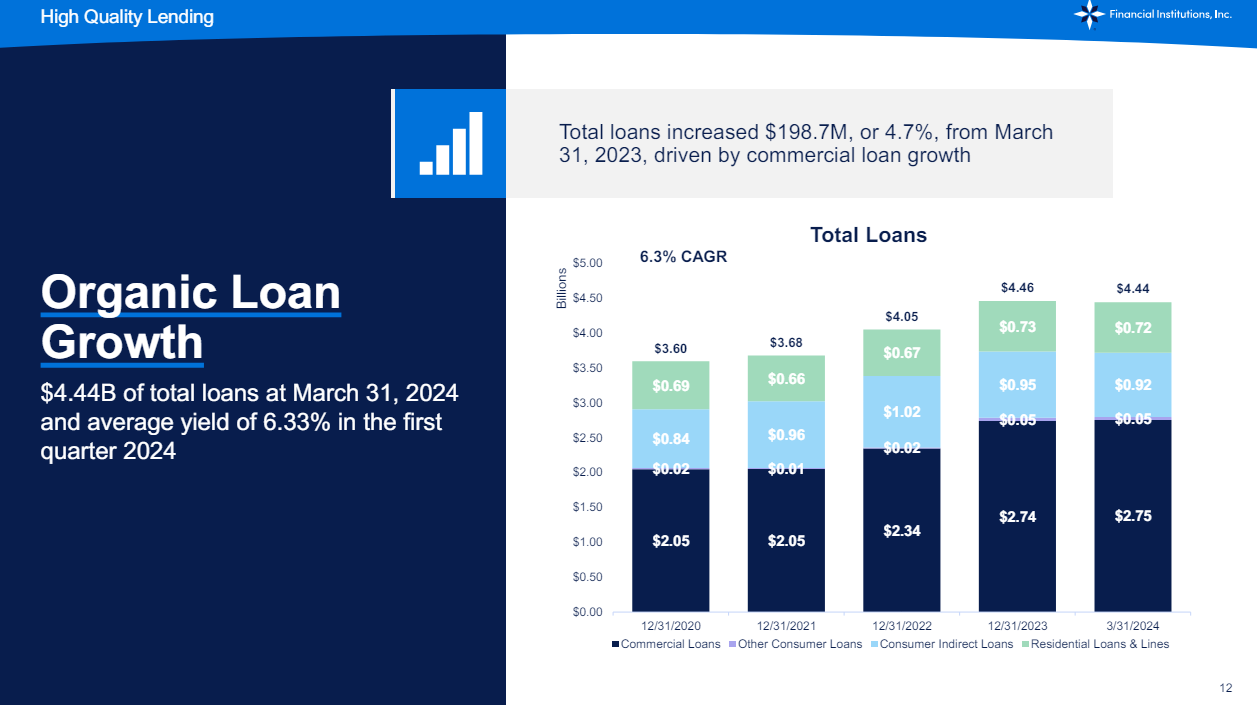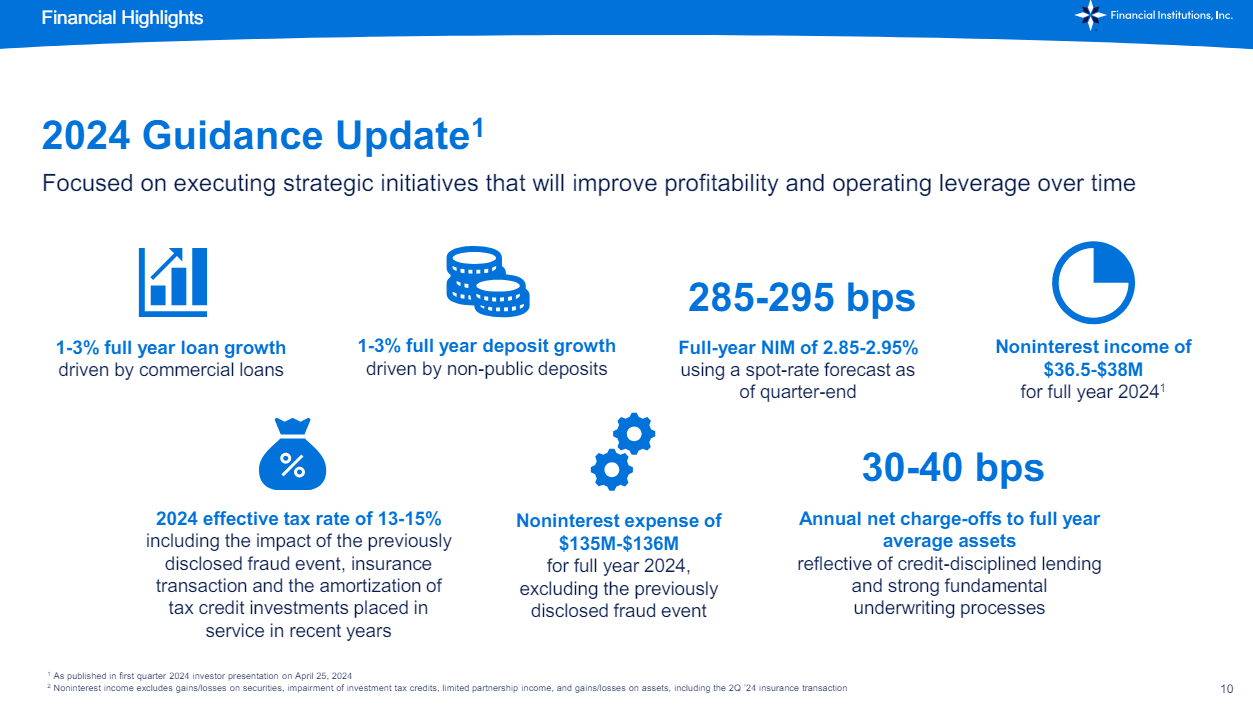Published on June 20th, 2024 by Josh Arnold
High-yield stocks pay out dividends that are significantly higher than the market average. For example, the S&P 500’s current yield is only ~1.2%.
High-yield stocks can be very helpful to shore up income after retirement. A $120,000 investment in stocks with an average dividend yield of 5% creates an average of $500 a month in dividends.
Financial Institution, Inc. (FISI) is part of our ‘High Dividend 50’ series, where we cover the 50 highest yielding stocks in the Sure Analysis Research Database.
You can download your free full list of all high dividend stocks with 5%+ yields (along with important financial metrics such as dividend yield and payout ratio) by clicking on the link below:
Next on our list of high dividend stocks to review is Financial Institutions, Inc. Financial Institutions has a 13-year dividend increase streak, which is decent given it’s a small bank.
Looking ahead, we think the bank has runway to continue to increase its dividend for the foreseeable future, and support its ample current yield.
Business Overview
FISI is a holding company for Five Star Bank, which is a chartered community bank in New York.
It offers the typical mix of traditional banking products, including checking an savings accounts, certificates of deposit, retirement and qualified plan accounts, commercial and real estate lending, business loans, working capital loans, and more.
The bank was founded in 1817, and is headquartered in Warsaw, New York.
Source: Investor presentation
The bank has 49 offices in New York state, and has more than $6 billion in total assets. The bank’s loan-to-deposit ratio is 82% as of the most recent quarter.
FISI reported first quarter earnings on April 25th, 2024, and results were largely flat year-over-year, with the exception of a fraud event that cost the bank dearly during the quarter.
Loans and deposits were up about 5% year-over-year, but net interest income fell about 4%. Net interest margin fell sharply, ceding about 30 basis points from the year-ago period, which was attributable to the higher cost of deposits.
The bank’s earnings-per-share plummeted 86% year-over-year from the check kiting scheme it suffered, but that should be a one-time incident.
Growth Prospects
We expect modest 2% growth from the bank going forward, as FISI has struggled at times to boost its revenue and margins. One thing FISI has done to help support growth is to expand its loan book, which was recently driven by commercial loan growth.
Source: Investor presentation
The company has managed to grow its loan book nicely in recent quarters, and the average yield is now up to 6.33%. However, lending costs – mostly via deposit cost increases – have offset that growth in recent quarters.
With rates seemingly having topped for this cycle, we believe the average loan yield for FISI may have some downside risk, regardless of how large the loan book is.
Source: Investor presentation
For this year, the management team expects full-year loan growth and deposit growth at 1% to 3%. That growth rate is off from recent results, while full-year net interest margin is expected to be under 3%.
With these numbers in mind, we are cautious on FISI’s ability to grow going forward, and think there is more downside risk to earnings than upside currently.
Competitive Advantages & Recession Performance
Like other banks, competitive advantages are tough to come by for FISI. In essence, FISI offers the same products and services as just about any other bank, so they can really only compete on pricing, and to a lesser extent, local office location.
However, neither of these things is a big or sustainable advantage, so we do not believe FISI has any meaningful competitive advantages.
Recession resilience is similarly fairly weak, as banks are beholden to economic conditions to a large extent. FISI’s credit quality has proven to be pretty good, which will certainly help when the next recession strikes.
The company performed decently during the previous major economic downturn, the Great Recession of 2008-2009:
- 2008 earnings-per-share: $1.96
- 2009 earnings-per-share: $1.28
- 2010 earnings-per-share: $1.62
FISI was able to rebound in 2010 fairly quickly from the bottom in 2009, and importantly, remained comfortably profitable during the worst of the recession.
This is a function of strong credit quality for FISI, and we note that earnings rebounded quite rapidly in the years following the recession.
Dividend Analysis
FISI’s current dividend is $1.20 per share, which means the stock is currently yielding 6.8%, or more than five times that of the S&P 500.
Earnings for this year are expected to be $2.90, which would be the lowest tally since 2020, should it come to fruition. That would still afford FISI a payout ratio of just over 40%, so the payout looks quite safe at the moment.
FISI’s dividend has moved up rapidly in the years since the Great Recession, having been boosted 13 consecutive years. We think the current dividend is not only safe, but is able to be raised down the road, barring a sizable decline in earnings.
We expect dividend growth to be roughly equal to earnings growth for the foreseeable future. We note that on a pure income basis, the company’s 6%+ yield is attractive.
Final Thoughts
We see FISI’s track record of dividend growth, as well as its very high yield, as attractive for income investors at the moment. We think the company’s ability to maintain and raise the dividend is quite strong for the foreseeable future.
However, FISI has little to no competitive advantages, and is subject to economic conditions it has no control over. We believe the next harsh recession has a good chance of forcing management to cut the dividend, and earnings are likely to suffer.
For now, we see the valuation as attractive, the yield is obviously quite strong, and we think the low base of earnings is sufficient to produce at least modest growth going forward.
If you are interested in finding high-quality dividend growth stocks and/or other high-yield securities and income securities, the following Sure Dividend resources will be useful:
High-Yield Individual Security Research
- 20 Highest Yielding Monthly Dividend Stocks
- 10 Super High Dividend REITs
- 5 Highest Yielding Royalty Trusts
Other Sure Dividend Resources
- Dividend Kings: 50+ years of rising dividends
- Dividend Champions: 25+ years of rising dividends
- Dividend Aristocrats: 25+ years of rising dividends and in the S&P 500
- Dividend Achievers: 10+ years of rising dividends and in the NASDAQ
- High Dividend Stocks: 5%+ dividend yields
- Monthly Dividend Stocks: Individual securities that pay out every month
- MLPs: List of MLPs and more
- REITs: List of REITs and more
- BDCs: List of BDCs and more



